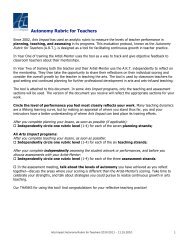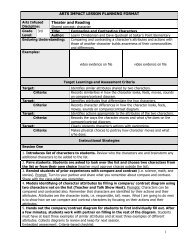Autonomy Rubric for Teachers - Arts Impact
Autonomy Rubric for Teachers - Arts Impact
Autonomy Rubric for Teachers - Arts Impact
You also want an ePaper? Increase the reach of your titles
YUMPU automatically turns print PDFs into web optimized ePapers that Google loves.
Dear <strong>Arts</strong> <strong>Impact</strong>/<strong>Arts</strong> Leadership <strong>Teachers</strong>:<br />
AUTONOMY RUBRIC FOR TEACHERS (A.R.T.)<br />
INDICATORS OF TEACHER’S AUTONOMY FOR ARTS INSTRUCTION<br />
Once again it is time to complete the <strong>Autonomy</strong> <strong>Rubric</strong> <strong>for</strong> <strong>Teachers</strong> (A.R.T.). This year you will be filling out the A.R.T.<br />
in reflection of your autonomous teaching of the full curriculum in Dance, Theater and Visual <strong>Arts</strong>.<br />
In 2009-10 we ask that you use the teaching and assessing strands of the tool to chart your own growth in teaching<br />
across all three disciplines.<br />
Just circle the level of per<strong>for</strong>mance you feel most closely reflects your work. Be sure to circle only one level, even if<br />
you feel you are ‘somewhere in-between’ levels.<br />
Independently CIRCLE ONE rubric level (4-1) <strong>for</strong> each of the six teaching strands as soon as possible after you<br />
complete teaching the final lesson in all three disciplines.<br />
Independently CIRCLE ONE rubric level (4-1) <strong>for</strong> each of the two assessment strands as soon as possible after<br />
you complete assessing the artwork in Visual <strong>Arts</strong> and student per<strong>for</strong>mances in Dance and Theater. Thanks <strong>for</strong> using<br />
this tool! And congratulations on your reflective teaching practice.<br />
Teacher Name _______ School Date<br />
Rater: _______Self _________________________Artist-Mentor _______Evaluator/Staff<br />
Directions: Circle the description <strong>for</strong> each strand that best illustrates TEACHING. (A-M=Artist-Mentor)<br />
TEACHING Teacher of arts….<br />
1. Uses instructional strategies which<br />
include:<br />
a. Warm-up<br />
Observations:<br />
4 3 2 1<br />
A-M steps in<br />
Mentions<br />
Omits warm-up in<br />
concept in<br />
teaching<br />
warm-up<br />
Uses warm-up activity<br />
to preview<br />
conceptual<br />
understanding<br />
Uses a warm-up<br />
with no<br />
connection to<br />
concept<br />
b. Sequencing<br />
Observations:<br />
Sequences all steps<br />
in order<br />
Sequences<br />
major steps<br />
Teaches some<br />
steps but omits<br />
major step(s)<br />
Leads lesson with no<br />
perceivable sequence<br />
c. Pacing<br />
Observations:<br />
Uses optimum time<br />
<strong>for</strong> each segment<br />
Falls behind or<br />
moves too<br />
quickly<br />
Loses track of<br />
time or doesn’t<br />
complete<br />
lesson<br />
Makes unsuccessful<br />
ef<strong>for</strong>t to complete<br />
lesson<br />
d. Embedded assessment<br />
Observations:<br />
e. Classroom management<br />
Observations:<br />
f. Creative, original responses<br />
Observations:<br />
Embeds multiple<br />
criteria-based<br />
assessment<br />
strategies<br />
Provides safe,<br />
structured<br />
classroom setting,<br />
material<br />
organization, and<br />
procedures<br />
Brainstorms <strong>for</strong><br />
individual<br />
responses that meet<br />
criteria<br />
Uses criteriabased<br />
assessment<br />
Prepares<br />
classroom, but<br />
lacks structure<br />
<strong>for</strong> classroom<br />
setting, material<br />
organization,<br />
and procedures<br />
Reminds<br />
students there<br />
are a range of<br />
responses that<br />
meet criteria<br />
Assesses<br />
without criteria<br />
focus<br />
(beauty,<br />
complexity, etc.)<br />
Attempts to<br />
prepare<br />
classroom<br />
during lesson<br />
Limits<br />
solutions that<br />
meet criteria<br />
Omits assessments<br />
Omits classroom<br />
management<br />
strategies from<br />
teaching<br />
Models and expects<br />
only one artistic<br />
answer<br />
09-10 AI-AL <strong>Autonomy</strong> <strong>Rubric</strong> <strong>for</strong> <strong>Teachers</strong> (A.R.T.) SW
AUTONOMY RUBRIC FOR TEACHERS (A.R.T.), continued<br />
Directions: Circle the description <strong>for</strong> each strand that best illustrates ASSESSMENTS. (A-M=Artist-Mentor)<br />
ASSESSMENT AND EVALUATION<br />
Teacher of art…<br />
6. Uses assessment/evaluation strategies which include:<br />
.<br />
4 3 2 1<br />
A-M discusses<br />
impact on lesson<br />
a. Reflection<br />
Observations:<br />
Recalls and analyzes<br />
specifically why<br />
targets were<br />
achieved/ not<br />
achieved<br />
Recalls and<br />
analyzes<br />
general target<br />
achievement<br />
Recalls general<br />
lesson<br />
success or<br />
breakdowns<br />
Relates successes/<br />
breakdowns<br />
inaccurately<br />
b. Criteria focus<br />
Observations:<br />
Scores using criteria<br />
as only focus<br />
Scores with<br />
inconsistent<br />
attention to<br />
criteria<br />
Scores with<br />
subjective<br />
comments<br />
Omits criteria-based<br />
scoring from<br />
assessments<br />
09-10 AI-AL <strong>Autonomy</strong> <strong>Rubric</strong> <strong>for</strong> <strong>Teachers</strong> (A.R.T.) SW
















